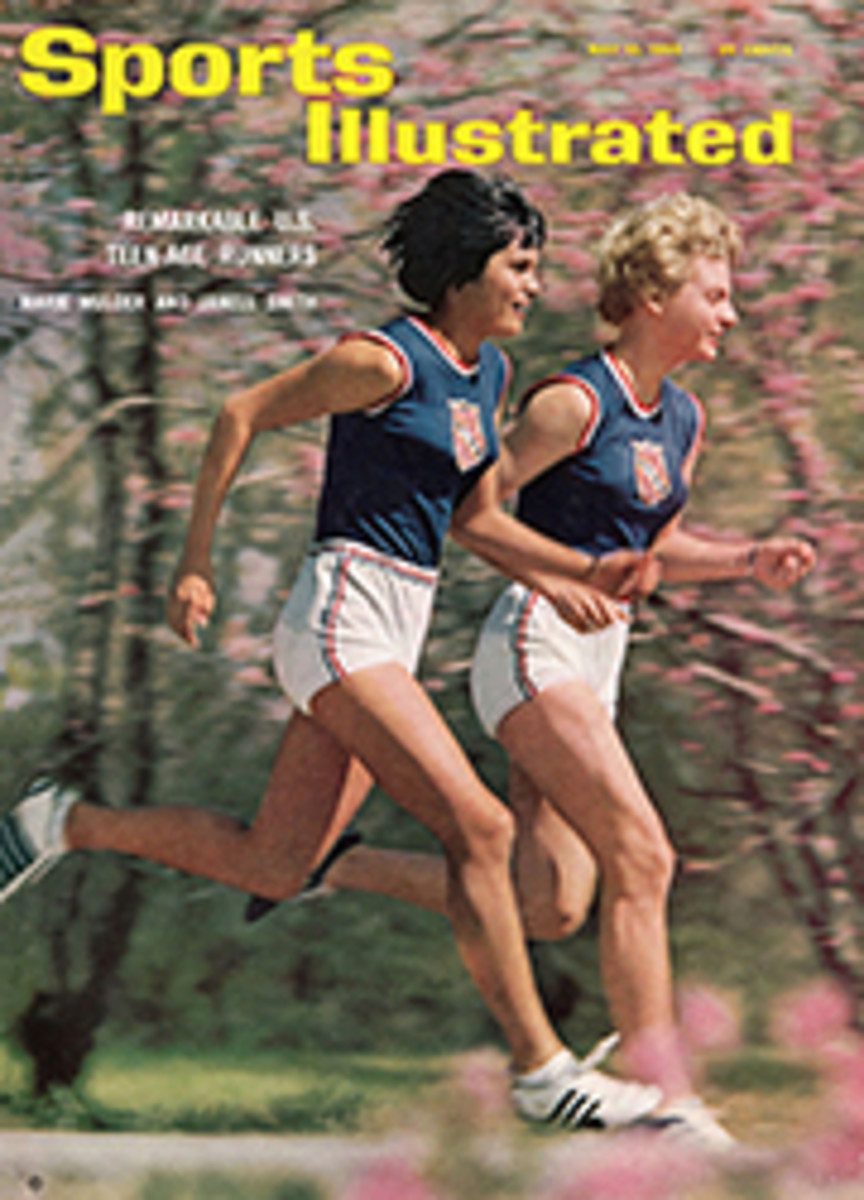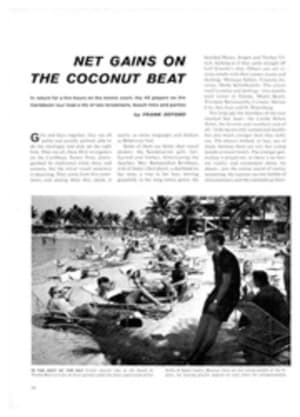
The playing and the partying were loovly
Oh, well done, Nomads!"
"Useful foot!"
But a kilted piper in the stands blew a discordant skirl of disapproval.
"Scrum it up lads!"
Eton? Cambridge? No, Cartier Field, Notre Dame, Ind. But the scene, except for a few anomalies, could have come from Tom Brown's School Days.
Fifteen intense players in the green shirts and white shorts of the Notre Dame Rugby Club were tearing up and down the field with 15 equally rapt players wearing the blue-and-white-striped jerseys and blue shorts of the Toronto Rugby Club. They converged and spread apart, hurled themselves in vicious tackles, punted, drop-kicked and place-kicked, and lateraled the ball underhand while soaring horizontally through the air. This was the final of the First Notre Dame Invitational Rugby Tournament, considered to be, because of the strength of the teams, the most important American Rugby tournament of the season. On the previous day, playing on a puddled field, Notre Dame had beaten Columbia and Virginia, while Toronto was skidding by Indiana and Army.
Now on the slick stadium grass, with the fat yellow ball as slippery to handle as a wet watermelon, the two fine teams vied for the Irish Challenge Cup. Toronto supporters, some in blazers and straw hats bearing the legend NOMADS. wandered up and down the sidelines, closely following the play.
"Loovly, loovly, loovly!" one of the Toronto fans cried as a Toronto player punted over the sidelines.
"He found touch," explained the public-address announcer in rich British accents, then immediately translated: "He kicked it out-of-bounds."
A moment later it was Notre Dame's turn to cheer as its fast backs, dodging and lateraling the ball across the field, brought it into Toronto territory.
"Nomads, get a bloody grip!" one of Toronto's supporters urged in alarm.
"Oh, well done, scrum!" shouted a Notre Dame player with an American accent when teammates moved the ball upheld with a series of short kicks. Suddenly a Nomad intercepted a lateral.
"That'll give their chaps something to ponder on," a Toronto man murmured.
But a Nomad ballcarrier was hit from the blind side.
"Kill 'im!" a less pensive Notre Dame rooter shouted.
Gay Pang, a 145-pound Hawaiian who plays fly-half for Notre Dame, was bowled over by a Toronto player. He slid 20 feet on the grass and five feet more on the cement bordering the sidelines. Before he had come to a proper rest he was up and rejoining the melee.
"Loovly, loovly," somebody said.
The teams were evenly matched. The Toronto Nomads, an amateur club made up of Englishmen, Scotsmen and Australians as well as Canadians—and the best team in eastern Canada—knew the game better than the Notre Dame boys and had the advantage in kicking; Notre Dame had the faster backs and stronger, more determined forwards. "The first half ends nil-nil," intoned the announcer, and the players took a five-minute rest.
Rugby, a game that originated in England in 1823 when a soccer player picked up the ball and ran, is the direct father of American football, but few Americans find it easy to get the hang of the daddy sport. They have to learn terms like scrum-down and line-out and the special duties of positions like hooker, prop, lock, loose-forward, inside three-quarters, second row and scrum-half. They have to learn to punt while running, to tackle high to prevent the ballcarrier from passing the ball to a teammate and to give up the ball instead of trying to run with it. "American players have a tendency to take the ball and die with it," says Bob Mier, who helped bring Rugby to Notre Dame. "If you don't keep possession of the ball, a long run is useless. The trick is to pass just as you're about to be tackled."
The game is full of gentlemanly traditions. Players are not supposed to bait the referee. When a fight seems likely, teammates hurl the incipient combatants apart and persuade them to shake hands. This gesture calls for applause. It is also a tradition to be stoical about injuries. If a player decides he is so badly hurt he cannot continue, his team plays a man short since substitutions are not allowed. In the first half of the Notre Dame-Virginia game, Notre Dame Forward John Mauro took an awkward fall and broke his arm, but he kept playing. When the arm became almost intolerably painful in the second half, he carefully shied and took the brunt of punishment on the other arm.
To many American players the Rugby tradition that compensates for aches and sprains and muddy faces is the Rugby party, where the host team entertains the visiting team or teams as lavishly as it can afford. The game is forgotten, and everyone bathes in a spirit of conviviality. Toasts are drunk, friendships are struck and Rugby songs, such as The Sex Life of the Camel, are sung. A team that has lost the game often can find solace by winning the party.
On the eve of its tournament, the Notre Dame Rugby Club threw an informal smoker and followed this with a more formal banquet. As Rugby parties go, the smoker, in a South Bend hotel, was a mild affair. Toronto is said to have won. The second party—held the night before the final—was quite another thing. Scotch bagpipers played rousing marches. Pretty girls attended from colleges far and near. In the English tradition pints were hoisted and enthusiastic singers stood on tabletops. A kind of hockey was played on the floor with brooms for sticks and, of course, Jello for the puck. In the background was a dance band playing brassy music for such traditional dances as the frug and the jerk. Past games were replayed, past parties were recalled and friendships were cemented. Later a mirror got smashed, a telephone was mysteriously pulled off the wall, one team gave a hotel room a good hosing and another team was requested to move out of the hotel. Toronto was adjudged the winner, with a two-way tie for second. The party was one of the best ever.
Apart from enjoying the challenge of such rigorous partying, most collegiate players got into Rugby because they were either too small to play bigtime football, or gave up football for a sport that allowed them to perform like two-way quarterbacks—passing, running, kicking and tackling. Some simply preferred Rugby's more "civilized" atmosphere. An Indianan, who had played high school football, recalled with a shudder his coach's "psyching" trick of pasting pictures of opposing players in each man's locker before the upcoming game. The word "Hate!" was written over each picture. "Rugby has a lot more dimension than most major varsity sports," he said, "because you respect your opponents as nice guys, even though they're trying to cream you on the field."
Whatever their reasons, undergraduates and some graduate students are joining college Rugby clubs at an ever increasing rate, especially in the Midwest. Five years ago, there were none outside the St. Louis area. Now seven Big Ten universities have clubs, as well as the U. of Chicago. In a year, estimates Victor Hilarov, president of the Midwest Rugby Football Union, every Big Ten school will have a Rugby club, The game appeals to all types: Wisconsin has a French count, Minnesota has a sky diver and Indiana has a bullfighter on its team. Football players make up the nucleus of the strong Stanford team, where Rugby is a varsity sport, and California, which probably has the best Rugby team of all the colleges, has been invited to play in Australia. At Yale and Princeton football players get their off-season knocks by playing Rugby. Yale can field three teams, and among its players are Derrick Bush, who plays on the Brazilian National team in the summer, and Tony Dunn, captain of this year's football team. On Princeton is Stan Malisewski, an All-Ivy League football player.
The disadvantage of playing for a college club is that money for travel, equipment and entertaining is hard to come by. The Notre Dame club wanted to raise funds by having the football team, no member of which plays Rugby, take on the Chicago Bears in basketball, but this was vetoed. The club is now thinking of selling blood to a blood bank. "We might as well get paid for spilling it," said a second-stringer.
Notre Dame, however, spills whatever blood it spills to good purpose. Of all college teams, it has made the greatest strides in attracting applicants and in improving its skills. Five years ago Bob Mier, who played Rugby in his home town of St. Louis, got together with Ken Featherstone, a professor of architecture, and founded the Rugby Club. The first 25 players turned out and the team had a 3-5-2 record. Last fall 90 players answered the call for recruits, and Notre Dame continued its triumphant ways, winning 19 straight games before losing.
In the second half of the Toronto Nomad game a drizzle started and colorful umbrellas mushroomed in the stands. The game got rough. At one point Mike Murphy, the 6-foot-5, 210-pound Notre Dame captain, slammed into a smaller Toronto player and knocked him fiat. The grounded Nomad lay still in the cold drizzle while play moved around him. A second Nomad was knocked down, and he lay still. Finally the ball was kicked cut-of-bounds. Helped by their teammates, the fallen pair clambered to their feet and announced they were ready to play. The Notre Dame players, as is traditional, applauded the boys' pluck, while the Torontonians applauded the sportsmanship of the Notre Dame team.
Play moved quickly up and down the field with no score until, with only 15 seconds to go, Notre Dame was awarded a penalty kick near the Toronto goal.
"A bloody gyp," a Toronto follower said quietly.
The ball, to the dismay of Toronto, was 15 yards from and directly in front of the goalposts. Jamie Toohey, the star kicker on the Notre Dame team, dug a hole in the turf for the ball to rest in and stepped back a few paces. He calmly sighted the crossbar, stepped forward swiftly and with a smart kick sent the ball soaring between the uprights. It was three points for Notre Dame, and a moment later the game ended. Notre Dame had captured the Irish Challenge Cup.
Maintaining tradition, the winners formed two lines and applauded the losers through, and the losers formed two lines and applauded the winners through. Just before the huge silver trophy was presented to a mud-covered Murphy, the players swarmed over one another and sang No Bloody Use at All. You could not tell winners from losers.
PHOTO
GRIMACING IRISH CAPTAIN MIKE MURPHY LEAPS FOR BALL AGAINST TORONTO NOMADS

